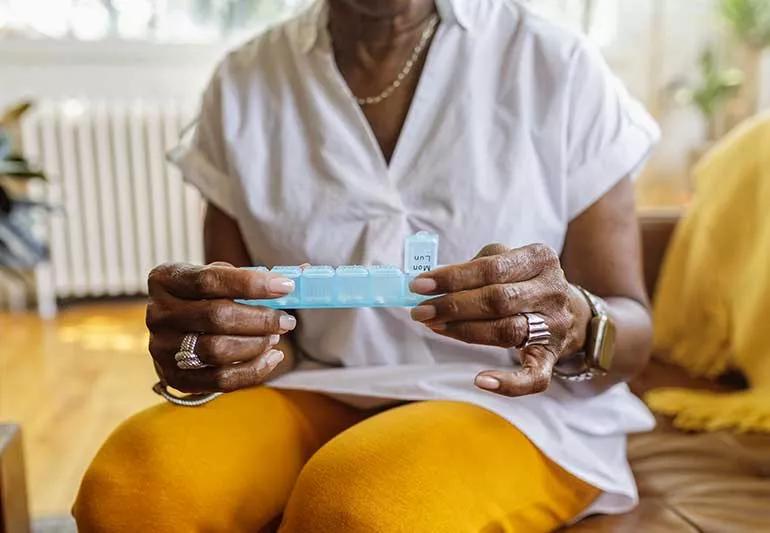It’s always best to talk to a healthcare provider before taking any supplements to avoid toxicity

You’ve probably heard about the importance of vitamin D (also called calciferol) throughout your life, in part because one of the best ways to get it is through sun exposure. For decades now, indoor kids the world over have been chased outside because they “need to go get some vitamin D.”
Advertisement
Cleveland Clinic is a non-profit academic medical center. Advertising on our site helps support our mission. We do not endorse non-Cleveland Clinic products or services. Policy
But you may also have heard that it’s also possible to get too much vitamin D. So, is this the moment where those of us who prefer to bask in the glow of a TV screen finally get our revenge? No, not exactly. Vitamin D deficiency is a real problem in many parts of the world, and many of us may benefit from taking vitamin D supplements, sometimes, alongside vitamin K.
And yet, too much of a good thing — including supplements — tends to break bad.
Functional medicine specialist Melissa Young, MD, explains what happens if you have too much vitamin D in your system, and why we so often take vitamins D and K together.
Spoiler alert: The conclusion is the same as every other article you’ve ever read about supplements: You shouldn’t take them without talking to a healthcare provider first.
Vitamin D is a fat-soluble vitamin. It:
Vitamin D works in tandem with calcium to fortify your bones.
Your skin manufactures the vitamin after exposure to the sun’s ultraviolet rays. Plenty of people still spend their workdays outdoors, but, as Dr. Young puts it, “We are an indoor society now, and unlike our ancestors, we wear clothing and sunscreen.”
Advertisement
The normal range of 25-hydroxy vitamin D is measured as nanograms per milliliter (ng/mL). Many experts recommend a level between 20 and 40 ng/mL. Others recommend a level between 30 and 50 ng/mL.
Many Americans are deficient in vitamin D — something healthcare providers are able to determine through a standard blood test. The test measures your serum total 25-hydoxivitamin D, also known as a 25(OH)D, with results quantified by nanograms per milliliter, or ng/mL. You’re considered vitamin D deficient if your 25(OH)D level is less than 31 ng/mL.
Most Americans’ vitamin D levels are between 20 and 29 ng/mL, which qualifies as deficient. Most providers recommend using supplements to bring those levels up to at least 31 ng/mL, preferably higher. Dr. Young aims for a level between 40 and 50.
Wondering if you’re vitamin D deficient? Dr. Young suggests getting your blood tested and — if your provider thinks you need it — taking vitamin D3 supplements. You should see your provider every three months until you reach steady vitamin D blood levels. According to Dr. Young, that usually takes three to six months.
After that, checkups every year should be fine, unless you have certain medical conditions like malabsorption (which impacts your absorption of supplements) or osteoporosis. In those cases, it might be more important to check your blood levels more frequently to be sure they’re optimum.
While there are still a lot of unanswered questions about the role vitamin D plays in our bodies, Dr. Young’s clinical experience is positive: “I see significant improvement in patients’ pain, mood and quality of life with vitamin D supplementation.”
So, how do you know when you’re overdoing it on the vitamin D supplements?
The recommended daily allowance (RDA) for vitamin D is determined by age, biological sex and whether or not you’re pregnant and/or lactating, but the National Institutes of Health recommends everybody get somewhere between 400 and 800 international units (IU) of vitamin D per day.
| Age | Male | Female | Pregnancy/Lactation |
|---|---|---|---|
| 0–12 months | 10 mcg (400 IU) | 10 mcg (400 IU) | |
| 1–13 years | 15 mcg (600 IU) | 15 mcg (600 IU) | |
| 14–18 years | 15 mcg (600 IU) | 15 mcg (600 IU) | 15 mcg (600 IU) |
| 19–50 years | 15 mcg (600 IU) | 15 mcg (600 IU) | 15 mcg (600 IU) |
| 51–70 years | 15 mcg (600 IU) | 15 mcg (600 IU) | |
| >70 | 20 mcg (800 IU) | 20 mcg (800 IU) | |
| Age | |||
| 0–12 months | |||
| Male | |||
| 10 mcg (400 IU) | |||
| Female | |||
| 10 mcg (400 IU) | |||
| Pregnancy/Lactation | |||
| 1–13 years | |||
| Male | |||
| 15 mcg (600 IU) | |||
| Female | |||
| 15 mcg (600 IU) | |||
| Pregnancy/Lactation | |||
| 14–18 years | |||
| Male | |||
| 15 mcg (600 IU) | |||
| Female | |||
| 15 mcg (600 IU) | |||
| Pregnancy/Lactation | |||
| 15 mcg (600 IU) | |||
| 19–50 years | |||
| Male | |||
| 15 mcg (600 IU) | |||
| Female | |||
| 15 mcg (600 IU) | |||
| Pregnancy/Lactation | |||
| 15 mcg (600 IU) | |||
| 51–70 years | |||
| Male | |||
| 15 mcg (600 IU) | |||
| Female | |||
| 15 mcg (600 IU) | |||
| Pregnancy/Lactation | |||
| >70 | |||
| Male | |||
| 20 mcg (800 IU) | |||
| Female | |||
| 20 mcg (800 IU) | |||
| Pregnancy/Lactation | |||
But if you look at D3 supplements online, you’ll see that most commercial supplements have higher doses — usually either 1,000, 2,000, 5,000 or 10,000 IU.
There even are some supplements available through online retailers that claim to contain 20,000–50,000 IU of vitamin D. Unless you have a severe vitamin D deficiency and are being prescribed doses that high, taking that quantity of vitamin D on a daily basis without your provider’s approval may be dangerous to your health.
It’s not a good idea to assume that a supplement manufacturer has your best interests in mind. For that reason, you should talk to your provider about the best supplement to take, and the appropriate dose for your specific needs.
Advertisement
It’s important to note that newer studies question the benefits of vitamin D supplements for the prevention and survival from diseases in older adults. Those studies likewise question the wisdom of routine screening for vitamin D deficiency. As research continues, recommendations around vitamin D testing and supplementation may change.
How much vitamin D a person should take depends on how significant their deficiency is. In cases of severe vitamin D deficiency, your provider may prescribe a short-term course of very high-dose pills or injections. They’ll also monitor you to make sure your blood levels return to a normal range.
If your vitamin D levels are less-than-ideal, but aren’t below the 31 ng/mL mark, they’ll likely suggest you take an over-the-counter vitamin D3 supplement.
“I check vitamin D levels on most patients to know if they need supplementation,” says Dr. Young.
If you’re experiencing specific symptoms like depression, your provider may encourage you to take up to 4,000 IU (international units) of vitamin D per day.
Vitamin D blood levels become a problem when they approach 100 ng/mL. And it’s only possible to exceed 100 ng/mL by over-supplementation. In fact, there’s a name for it: Hypervitaminosis D.
Advertisement
Vitamin D helps our bodies absorb calcium — in other words, they work as a team.
If you have hypervitaminosis D, they’re working too well.
If you have too much vitamin D in your blood, it will cause extra calcium absorption. This, in turn, can lead to symptoms like muscle pain, mood disorders, abdominal pain, frequent urination and kidney stones.
It’s important to note that our bodies are smart. When it comes to vitamin D, they’re usually good at keeping things in check. We don’t get a tremendous amount of vitamin D from food, and our bodies regulate the amount of vitamin D they get through sun exposure.
Put simply: If you’re healthy and aren’t taking a supplement, you aren’t at risk for vitamin D toxicity.
I bet you’re wondering how vitamin K fits into this picture. Let’s first start with what it is. Vitamin K:
You can get vitamin K from leafy green vegetables, broccoli, Brussels sprouts, avocado, tuna and soybeans.
Unlike vitamin D, most people get all the vitamin K they need from their diet. Any extra vitamin K you get is stored in your liver, so it’s fairly rare to be vitamin K deficient.
If you go supplement hunting, you’ll probably notice that a lot of companies sell supplements that combine D3 and K2. While not conclusive, the science we have to date suggests that vitamin K has to come along for the ride. The theory is that it’s the third wheel that keeps vitamin D and calcium from getting up to any funny business: A 2020 review article in Nutrients found that vitamin K helps stops vascular calcification from progressing.
Advertisement
In 2009, the European Food Safety Authority (EFSA) released an opinion stating, “a cause and effect relationship has been established between the dietary intake of vitamin K and the maintenance of normal bone and normal blood coagulation.” They stopped short of saying that vitamin K benefits the heart and blood vessels. It’s also important to note that the U.S. Food and Drug Administration (FDA) hasn’t followed suit. As far as they’re concerned, the jury’s still out.
When it comes to vitamin K, we don’t really know how much is too much. Because nothing can be simple on the internet, a quick search will show you that researchers are still debating the existence of vitamin K toxicity.
If vitamin K toxicity exists, it’s rare, but potentially serious. Why? Because vitamin K may negatively interact with other medications you take. For example, vitamin K helps your blood to clot, so you should definitely not take it while you’re on a blood thinner such as warfarin (Coumadin®).
At this point, the best person to ask is your healthcare provider. Whether or not vitamin K supplementation makes sense for you depends on many different factors — and a provider is in the best position to do a proper risk/benefit analysis.
Vitamin and mineral supplements can be a good thing. But high doses can negate their health benefits — and even pose health risks. You’re most likely to benefit from taking vitamins D and K if you arm yourself with information about your body, what it needs and what it could do without. The only person who can help you determine that is — you guessed it — a healthcare provider.
Learn more about our editorial process.
Advertisement

Calcium, vitamin D and magnesium are essential — but you should supplement under doctor’s orders

Both micronutrients support body functions, but there are key differences, like what foods have them and what jobs they do

From leafy greens to heart-healthy oils, the selection is abundant

Vitamin K2 foods aren’t the usual suspects

Vitamin K2 is gaining recognition for its effects on blood clotting, heart health and bone health

It helps your bones stay strong and your blood clot, but it may also do so much more

This starchy root vegetable is a staple in many global cuisines — but it has to be prepared correctly, or it can cause serious concerns

These delicate green sprouts can give you an extra dose of vitamin K and other nutrients — but they’re not safe for everyone

Start having sex about 72 hours before ovulation, then at least every other day during your fertile window

Attachment theory suggests that your earliest relationships shape connections throughout your life

It isn’t a recognized mental health disorder, but research shows that problematic social media use can negatively affect your mental health, self-esteem and sleep